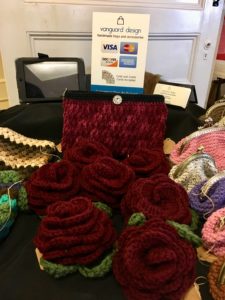Advice on Craft Business Selling
 As many of you know, in addition to all the work I do in journalism and digital marketing, I also find time to run a bespoke handbag business called Vanguard Design. It started out as a passion project for bag making many years ago and evolved into a part-time business. While I get most of my business through online sales, I do sometimes appear at craft fairs, as well as handbag trade shows with my collection. I get asked questions sometimes about what makes for a successful show table display. I am no expert, but I have done this enough times that I can share common mistakes I see with display tables.
As many of you know, in addition to all the work I do in journalism and digital marketing, I also find time to run a bespoke handbag business called Vanguard Design. It started out as a passion project for bag making many years ago and evolved into a part-time business. While I get most of my business through online sales, I do sometimes appear at craft fairs, as well as handbag trade shows with my collection. I get asked questions sometimes about what makes for a successful show table display. I am no expert, but I have done this enough times that I can share common mistakes I see with display tables.
- The number of products – I see this more at craft fairs, which attract hobbyists who want to sell their handmade items. Some people go over the top with the number of things they sell, which can hurt the bottom line. I went to a craft fair in New York City last summer, and I saw this woman who had a table with 20 different knitted products on it – mittens, hats, scarves, bags, beer covers, rugs, baby clothes, sweaters, blankets, coasters, etc. It was literally the Wal-Mart of knitted everything. What made it worse was that everything looked mediocre; like she didn’t even hide the tails on some of the items and she used mediocre yarn. I get the urge to try to sell a wide variety, but you can’t be all things to all people. It would be better to sell two or three products that you can make really well then to sell 20 items that are subpar. For example, my friend Cynthia only makes scarves and shawls, and she always sells out of them. All of her products look fabulous because she has mastered making them and uses the finest yarn. With that said…
- Developing Your Niche – When you are selling too many products, it gives the impression that you lack an identity for your craft and business. You can’t be a jack of all trades. Instead, you should focus on developing your niche craft that you are passionate about doing. Again, referring to my friend Cynthia, some of the best craft sellers know who they are and have a defined product for a specific audience.
- Unique Selling Point (USP) – If you are going into the craft selling business, you must find your competitive advantage. I make crochet, structured fabric, and leather bags because not many people sell those things at fairs. When you sell something unique, people will also remember you.
- Price Variety – Don’t price everything on your table at $100! Most people can’t and won’t spend that type of money, especially if they have never purchased anything from you before. When you are just entering the craft selling business, you are developing a relationship with potential customers. New customers will likely buy lower-priced items first, and then if they like your work, will spend more in the future. It is a good idea to have a price range. I would much rather make $100 off of items costing $5 or $10 than not to sell that one for $100 item!
- Presentation is everything – I hate to go to craft fairs to see beautiful handicrafts presented so poorly on a display table. You have to think about what would attract customers to your table, such as how the items are presented, using props, having price tags on everything, making use of attractive colors and designs, etc. Think of it this way, would you go to a department store that has its products thrown all over the place or no color and style coordination? No! So, put some thought into your table. Don’t forget to have proper signage and business cards so people will remember you after the craft fair.